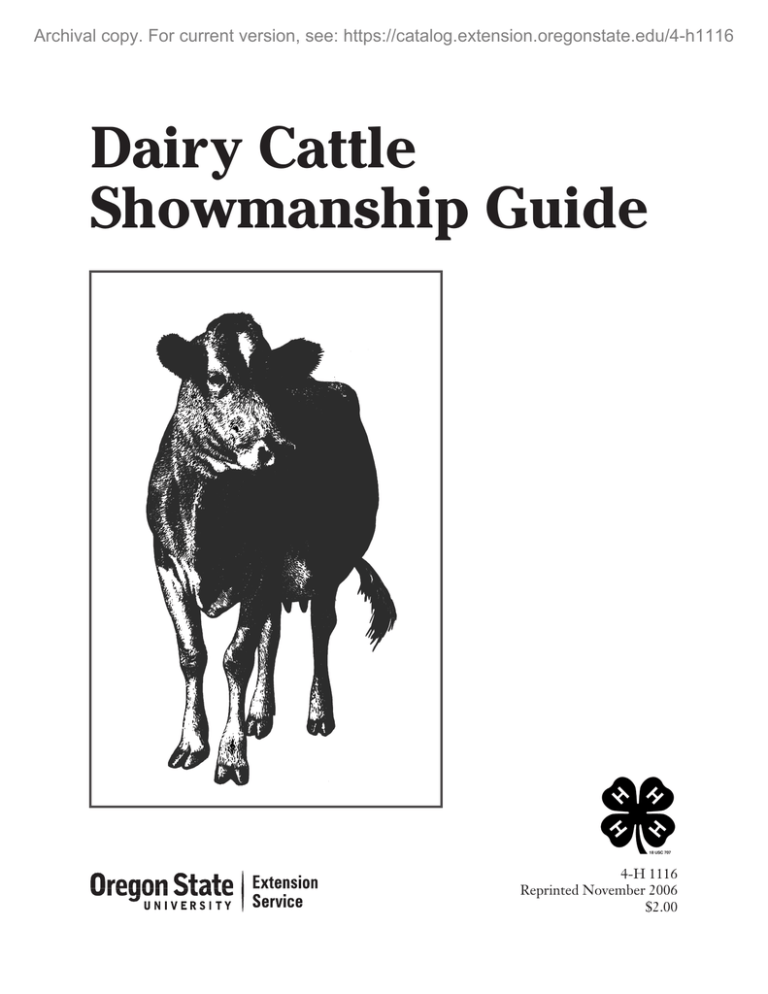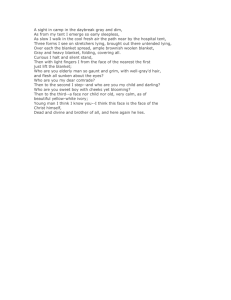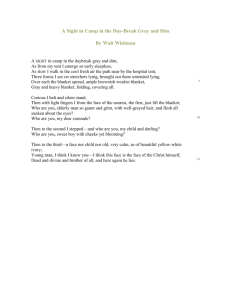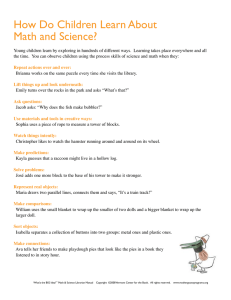Dairy Cattle Showmanship Guide Archival copy. For current version, see: 4-H 1116
advertisement

Archival copy. For current version, see: https://catalog.extension.oregonstate.edu/4-h1116 Dairy Cattle Showmanship Guide 4-H 1116 Reprinted November 2006 $2.00 Archival copy. For current version, see: https://catalog.extension.oregonstate.edu/4-h1116 It’s a pleasure to show a well‑trained dairy animal. Judges appreciate the chance to observe and handle well‑mannered dairy animals. They can’t properly judge unruly animals that can’t be controlled. Train your show animals to lead, walk, and pose correctly. A properly trained and shown animal provides much satisfaction to its owner. Feeding The feed mixture you use during the fitting period should be similar to the one you use at the show. You can use numerous satisfactory grain mixtures. The animal should be in good condition. Over condition, or excess fat, is penalized in judging. Fast‑growing, young animals require longer to condition than mature animals. Equipment Equipment for fitting animals includes a blanket, halter, rubber currycomb, soft brush, a bucket, and soap. Blanketing Plan to wash and blanket an animal as soon as she is put in the fitting quarters. Blanketing speeds the shedding of long hair and makes the hide soft and pliable. It also protects the new coat of hair grown under the blanket. It is short, soft, and retains a lustre if protected from the sun and wind. Once you start blanketing, continue until the show is over. Blankets made of burlap are inexpensive and satisfactory. You may place an old woolen or cotton blanket under the burlap blanket. When weather is extremely hot, remove the blanket during the day. Grooming Grooming once daily for a month makes hair glossy and the hide loose and pliable. Use a currycomb only to remove excess dirt on the legs and flanks; otherwise, you could do more harm than good. Use only a soft‑bristled brush—a stiff brush will scratch and roughen the hide. After brushing, smooth the hair lightly with a flannel cloth moistened with oil. A light mineral or vegetable oil is best. Washing Showpeople frequently wash the animal when fitting is started. For this job, choose a warm day and use lukewarm water and a mild soap. The first washing should be thorough. Be sure to wash under the flank. Frequent washing is undesirable because it removes the natural skin secretions and leaves the hide dry and harsh. However, wash out stains each day, and if the switch is white, wash and bleach it thoroughly. It’s important to rinse thoroughly. Clipping Clipping is no substitute for grooming. Do not clip the entire animal. The best practice is to clip the head, neck, tail, and in some cases, the belly. The belly of a cow should be clipped to show the milk veins. Clipping the belly of young heifers is not recommended, as it gives them a shallow‑ bodied appearance. The entire head should be clipped. It’s best to begin at the nose. Clip the neck to the withers, and down to the point of the shoulder, as shown in Figures 2 and 3. Clip the tail from a point just above the switch to the rump (Figure 4). Leave enough hair on the tail setting to give the rump the appearance of being long and level. Unless the hair is blended off carefully at the tail setting, the animal may appear to have a sloping rump. Clipping the udders of cows or springing heifers is also a desirable practice. Animals show to the best advantage when clipped not more than 3 or 4 days before showing. Most breeds follow the standards discussed above. Milking Shorthorn breeders suggest less clipping about the head and neck. Remember, for best results, clip your animal to show as an individual. Care of feet Trimming hooves is very important to the health, performance, and general well‑being of your animal. Consult your club leader or local commercial dairyperson about when and how to trim your animal’s hooves. Care of horns Good dairy management encourages you to remove the horns at a young age. If your animal has horns, smooth-polished horns improve its appearance. You can smooth down the roughest parts with a fine wood file. After filing, you can improve the surface further with a wood scraper, a piece of glass, or a section of a piston ring. Do not work off too much of the horn. It may weaken it, and the shell could be easily knocked off. Archival copy. For current version, see: https://catalog.extension.oregonstate.edu/4-h1116 Figure 1. Clip entire head to bring out character, expression, and cleanness of lines. Figure 2. Clip neck and shoulders to a line between top of shoulders and point of the shoulders. Clipping with lay of hair tends to blend clipped and unclipped areas. Figure 3. Ears, head, neck, and withers clipped improves neatness of appearance. Figure 4. Clip tail from switch to rump against lay of hair. Figure 5. Smooth top line of rump. Leave hair in low spots to sharpen lines. Blend by clipping with lay of hair. Figure 6. Ciip long hair off udder. Fine emery paper will make the horn surface even smoother. For final polishing, use powdered pumice stone, metal polish, or silver polish. Apply polishing materials to the horn as an oil paste. Polish with a flannel cloth. Training Cattle must be trained to pose and lead properly if they are to be shown to the best advantage. Lead the animal from the left side. An animal should respond to a light halter tug. Training an animal to lead is good experience for the prospective showperson. It requires patience and persistence. Teach the animal to stand with its legs squarely under it, its head erect, and the top line straight. A calf or heifer should have her hind leg back of the judge, slightly behind the other leg. Cows in milk should be posed with the hind leg nearest the judge, slightly ahead of the other leg. An animal should lead off or stop at the leader’s command. A good showperson always keeps the animal alert. When a pose is broken, the animal will often stretch or get out of balance unless carefully handled. Train the animal so that it will pose properly when spoken to or lightly touched with a hand. Animals usually refuse to lead at first; patience aids a great deal in starting off the animal properly. When an animal refuses to lead, it might help to take along another animal that leads well. Some showpeople are actual handicaps to their animals. This should never be the case. A good showperson can show the animal’s best points at all times. Animals also should be taught to step backward. This is done by applying pressure on the halter held in the left hand, and applying pressure on the point of the shoulder with the finger tips of the right hand. Braiding the switch Wash the switch thoroughly. While it is wet, braid it into three or four three‑strand braids. Do this the night before showing. Tie braids with strings. Don’t comb them out until just before entering the ring. Final preparations On the morning of the show, give the animal a liberal feed of hay, beet pulp, and grain. A medium “fill” will eliminate a gaunt look. Just before entering the ring, give the animal a drink of water. On Archival copy. For current version, see: https://catalog.extension.oregonstate.edu/4-h1116 Figure 7. Trim hair from inside and outside of ears. On Brown Swiss, you may leave a fringe of hair inside ears. Figure 8. Clip hocks and hind legs with lay of hair to show refinement, straight legs, and to clearly define tendons. Figure 9. Remove long hair from above knees to hoofs to show refinement. attitude and move quietly and hot days, an extremely cold drink with confidence. You don’t need could cause the animal to cramp. to be too serious; relax and smile. Too much “fill” is undesirable It’s important that you be a because it produces “pot bellies.” modest winner or a gracious Therefore, use careful judgment loser. Be quick to compliment in the amount of drink you give. others in the ring. Don’t criticize Immediately before entering or complain when you don’t win. the ring, wipe the animal with a Remember, losers often learn slightly oiled flannel cloth. Too more than winners in the show much mineral oil is very undesirring. able, but a small amount gives Figure 10. Braid switch wet the night before showing to set curl. Start loosely for several a gloss and makes the hair lie laps, then tightly; tie ends of braids. In the ring smoothly. After the oiled cloth treatment, rub down with the Enter the ring promptly when hands. This further improves the animal’s appearthe class is called. Keep your animal moving slowly, ance. Wipe out her ears and nose. but not too slowly, and follow the judge’s instructions. As you move around the ring, watch the Your grooming judge and respond to his or her instructions, but Your appearance in the ring makes an impresalso watch your animal so as to show her to best sion on the judge during conformation and showadvantage. When moving your animal, be sure to manship classes. You should be clean and neat. take wide corners. When the judge motions you This means you and your clothes should be clean, into line, move in promptly. “Show” your animal your clothes neatly pressed, and your hair neatly during the entire judging period and while the trimmed and combed. judge is giving reasons. When the animal steps out Blouses and pants or skirts are acceptable dress of pose, immediately move her back into position. for girls. Shirt and pants are the dress for boys. Keep your animal in a position where the judge Clothing of all colors is acceptable, although white can see her at all times. It’s very bad practice to dress is preferred by many participants in dairy jerk an animal. Train her to take short steps. When competition. in the show ring, give all your attention to your Shoes should be sturdy and provide protection. animal and to the judge. Remember to move the Flip-flops, sandals, and bare feet are unacceptable. animal’s posing position when the judge goes from Your courtesy in the ring speaks for your attione side to the other. When trading animals, reset tude. Be considerate of other showpeople. Respond its feet. readily to requests from the judge or ringmaster. A good showperson must be a good sport. Don’t jab, strike, or abuse your animals or use inapUnless you can lose with a smile, stay out of the propriate language. show ring. Those who see their faults and learn You’ll do much to impress the judge and those from mistakes improve for the next show. watching you in the ring if you keep a cool, calm Archival copy. For current version, see: https://catalog.extension.oregonstate.edu/4-h1116 Showing an animal in the ring • Do most of the showing with the halter lead strap and avoid stepping on the animal’s hind feet to move them. Leading • Step animal ahead by a slight pull on the lead strap. Enter leading the animal at a normal walk around the ring in a clockwise direction. Walk on the left side, opposite her head. Hold the lead strap, or rope, with the right hand quite close to the halter. Keep the strap neatly but naturally gathered (not necessarily coiled) in one or both hands. Holding close to the halter ensures secure control of an animal. • The animal should lead readily and respond quickly. • Use a halter that fits properly and correctly when placed on the animal. A leather halter with leather lead strap is best. • As the judge studies your animal, the preferred method of leading is to slowly walk backward facing the animal and holding the lead rope in the left hand with the remainder of it neatly, but naturally, gathered in one or both hands (face forward when leading at all other times). • Lead slowly with the animal’s head held high enough for impressive style, attractive carriage, and graceful walk. Posing • When posing and showing an animal, stay on its left side. Face at an angle, in a position far enough away to see the stance of her feet and topline. • Pose a heifer with feet placed squarely, and the hind leg nearest to the judge slightly behind the other one. When posing cows in milk, the hind leg nearest the judge should be slightly ahead of the other one. • Face animal up‑grade, if possible, with her front feet on a slight incline. • Neither crowd the exhibitor next to you nor leave enough space for another animal when you lead into a side-by-side position. • The animal may be backed out of line when the judge requests that her placing be changed. Many prefer to lead the animal forward and around the end of the line or back through the line. Do not lead the animal between the judge and an animal he or she is observing. • Move the animal back by exerting pressure on the shoulder point with the thumb and fingers of the right hand as you push back with the halter. • When the judge is observing the animal, let her stand posed reasonably well. • Be natural. Overshowing, undue fussing, and maneu­vering is objectionable. Show the animal to the best advantage Quickly recognize the conformation faults of the animal you are leading, and show so as to overcome them. You may be asked to exchange animals with another showperson and show his/her heifer for awhile. Poise, alertness, and attitude • Keep an eye on your animal, and be aware of the position of the judge at all times. Don’t be distracted by persons and things outside the ring. • Show the animal and not yourself. • Respond rapidly to requests from the judge and officials. • Be courteous and a good sport. • Keep showing until the entire class has been placed and the judge has given his or her reasons. Using a blanket It’s difficult to fit a dairy calf without using a blanket. The blanket keeps the calf clean and the hair in good condition. The calf should be blanketed at least 4 to 6 weeks before the first show date. Procedure and materials needed 1.Secure burlap sacks, snaps, rings, and buckles. 2.Split sacks. 3.Lay sacks over heifer’s back. 4. Take measurements for the blanket. (See Figure 11). Archival copy. For current version, see: https://catalog.extension.oregonstate.edu/4-h1116 5. Make a blanket according to descriptions in Figure 12. Lay out unassembled parts of a blanket. 6. Follow the fitting instructions of the blanket and securing of snaps, etc. (See “Procedure” below, and Figure 13). 7.Follow steps for the removal of a blanket. Why blanket? • If the animal’s hair is long and coarse, you may double the sacks to make a heavier blanket. When fitting for a spring show, you may need several layers of sacks in the blanket. • Always put the blanket on the shoulders first, then pull it down toward the rear of the animal. • Do not put a clean blanket on a dirty heifer. Figure 11. Determine the blanket size by the size of the calf. • Do not put a dirty blanket on a clean heifer. • When should the blanket be made in double thickness? • Blanketed calves should be kept in a dark, cool, well­-bedded stall. • Does blanketing eliminate all brushing and grooming? • Yearlings and cows should be kept blanketed during the day. They may be allowed to graze at night until about 3 weeks prior to show time. Procedure • Day and night confinement for 3 weeks prior to show day will accustom the animal to drink water from a bucket and tub, and to be content under show conditions. • When removing the blanket, unfasten all snaps and buckles, fold the rear 1⁄3 of the blanket forward, and lift the blanket gently upward and backward. • Remember, blanketing is not a substitute for brushing and grooming. Questions • Why should I blanket my calf? • When should I blanket my calf? • Where should I keep the blanketed calf? • Are cows and heifers handled the same when blanketed? Make the blanket so that the front edge covers the withers (1) and the lower point of the shoulders (3). The back edge should come to the tail setting (2), but not so far that it will be difficult to keep clean. Fasten the straps at points 4, 5, 6, and 7 on both sides. Then, tie the ends together, or arrange a device for fastening straps rather than tieing. The blanket should come an inch or two below the belly (8). To prevent tearing, sew a 4‑ to 6‑inch square of heavy material at each point where the straps are attached. It might be necessary to sew two or more bags together, depending on the size of the blanket. Sew all the straps on the under side of the blanket. Archival copy. For current version, see: https://catalog.extension.oregonstate.edu/4-h1116 This strap goes around belly just behind front legs. Buckle Sew double layer for strength. Buckle These straps go around the outside of hind legs, then between legs and up through hole in blanket and buckle. Double stitch edges all around. Buckle Hole for hind leg strap Buckle Figure 12. Detailed description of a blanket. 1 2 4 7 6 8 3 5 Figure 13. A diagram for making a blanket from burlap bags. Archival copy. For current version, see: https://catalog.extension.oregonstate.edu/4-h1116 This publication was developed by Dr. H.P. Adams, Extension dairy specialist emeritus; and Duane P. Johnson, Extension 4-H specialist emeritus; with the assistance of the development committee for animal science projects. A portion of the material was adapted from an Oklahoma State University publication. This publication was produced and distributed in furtherance of the Acts of Congress of May 8 and June 30, 1914. Extension work is a cooperative program of Oregon State University, the U.S. Department of Agriculture, and Oregon counties. Oregon State University Extension Service offers educational programs, activities, and materials without discrimination based on age, color, disability, gender identity or expression, marital status, national origin, race, religion, sex, sexual orientation, or veteran’s status. Oregon State University Extension Service is an Equal Opportunity Employer. Reprinted July 2001. Reprinted November 2006.



